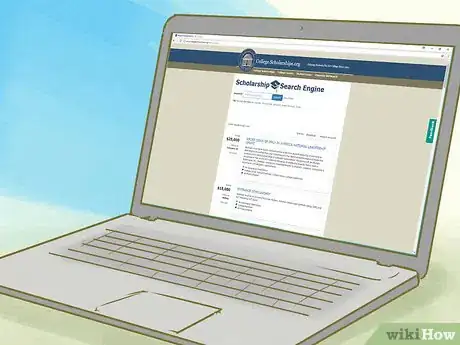This article was co-authored by Felipe Corredor. Felipe is a Senior College Admissions Consultant at American College Counselors with over seven years of experience. He specializes in helping clients from all around the world gain admission into America's top universities through private, one-on-one consulting. He helps guide clients through the entire college admissions process and perfect every aspect of their college applications. Felipe earned a Bachelor's Degree from the University of Chicago and recently received his MBA.
This article has been viewed 220,760 times.
Whether the "college" you're looking for means taking a college-level class or earning a full degree, there are strategies that can be applied for reducing or eliminating the financial burden that usually accompanies higher education. When done right, college can get you where you need to go without putting a serious damper on your wallet.
Steps
Getting Need-Based Financial Aid
-
1Calculate your financial need. If you feel your family can't afford to pay for your college education, chances are some colleges will agree. Financial need is a calculation from information included on your FAFSA, or federal financial aid application. It takes into account your family's income (usually but not always your parents, with modifications for single-parent families), the number of children in your family, particularly college-aged children, and investments or other assets your family might have. These factors are used to determine how much your family can afford to pay for your college education -- your Expected Family Contribution.[1]
- Use a calculator like the FAFSA4caster, found on the FAFSA website, to estimate your family's financial need.
-
2Fill out the FAFSA. This stands for Free Application for Federal Student Aid and is the standard financial aid form for colleges and universities in the United States. Fill out this form and submit it to each school you're applying to by their stated deadlines. Make sure all information is correct to the best of your knowledge, and supply any documents or other proof if necessary.
- This does not mean you're attending and does not mean that you have to accept anything – you're simply showing interest and getting a quote. It is completely standard procedure.
Advertisement -
3Submit tax documents and any other forms, too. Each school has its own application process, so check with each school you're applying to to figure out exactly what needs to be submitted and when.
- Most schools will require a copy of your recent tax documents, and other documents or forms may be requested as well. Double check each school's requirements, and contact their financial aid officers if you have questions about applying for need-based financial aid.
- The financial aid application process may be different for transfer or international students. Make sure you follow the right process for your background and education.
-
4Consider your offers and make your decision. If you've gotten into several different schools, you've likely received several different financial aid offers. Don't just pick the biggest one. Instead, consider the cost of attending each school as compared to their offer. Many schools promise to match other offers you get, so negotiate with a school's financial aid office to try to get a better deal.
- Think about the types of aid you're getting. Loans may be helpful now, but you could end up graduating deeply in debt. Work study programs will help you pay for your education, but could end up distracting you from your studies. Decide what type of aid you like best, or pick a mix to minimize your risks.
-
5Throughout college, maintain your scholarship. Submit an updated FAFSA and tax forms annually. Make sure you keep your school's financial aid office informed about any changes in your financial situation, and pay close attention to deadlines.
- Your school may even offer you more money later if you get good grades and show your potential. Once in a while there is scholarship money "left over" that you could be eligible for if you stay on top of your game.
Finding Cheaper Alternatives
-
1Look at community colleges. Most people think of college as going to a public or private university. In reality, there are plenty more options, like community colleges – and they're much, much cheaper. You can find a local one to avoid the costs of moving, too.
- What's more, most, if not all, of your credits will transfer. You can go to a community college for one or two years on the cheap and then move over the a state or public university. If your grades are really good, you could even be up for more scholarships.
-
2Consider vocational schools. Nowadays, having a bachelor's in something doesn't mean much. Plenty of people graduate from college and go back to food service. You don't have to go to a legitimate university to get an education and to get a good paycheck – vocational schools can make that happen, too.
- Check this out: 50% of college grads are unemployed or underemployed. Meanwhile, trade workers with skills are in huge demand. 40% of surveyed employers in a recent survey complained that they couldn't find enough. Going to a trade or vocational school may be a much, much better move.
-
3Consider going part-time. There's no reason you should have to devote all your time and money to a full-time education. Take a few classes at a time if that's all you can afford – and that way you can keep working, too. Every school offers different levels of involvement. You could go part-time or you could just take one class. It's up to you.
- Look into taking classes taught by part-time teachers. Part-time teachers are paid less and therefore taking their classes usually costs less, too.[2]
-
4Go the online route. While many online schools are a joke, there are a growing number that are not. They're cheaper and save you the cost of transport. What's more, you can do them on your own time, so you can still work if need be. They're also a good transition into a full-time college career down the line as many credits will transfer.
- If you are looking to transfer later, look into the policy. Be sure you're attending an accredited, respected online institution before assuming. Take a look at the colleges you want to attend, too, and check if your credits would transfer.
-
5Look into MOOCs. A growing trend in the realm of technology and education is the MOOC -- a massive open online course. Some are available for credit or certificate and some aren't, but they're springing up all over the place. It's a course that's videotaped or recorded at a university and 100% of it is put up online. It's essentially attending a whole bunch of different online universities.
- Look at Harvard and MIT's websites, for example. You can peruse their courses and launch into whatever interests you.
- There are also websites like Coursera that coordinate with dozens of schools to provide varied, coordinated curricula. You can take their classes for free with or without a certificate at the end.
-
6Try a "cooperative education program." This type of program is where you spend one semester studying full-time and the next working full-time. It's not based on financial aid and only offered at certain institutions; if it's offered at one you're looking at, it's worth a shot. On average, students going this route earn as much as $7,000 per school year.
- This also gets you work experience in your field from the get go. You're making money and building your resume at the same time. In addition to these perks, many colleges take the work experience as school credit. It may not take you that much longer to graduate if your job is in line with your studies.
-
7Audit classes. Find a local university or community college and look up their auditing policies. Some schools will let anyone interested audit large classes, while other schools allow only full-time students to audit. Find a school that will let you audit, consulting the registrar or other officials where necessary.
- Ask the professor for permission to audit the class. Email the professor well before the first class meeting and explain your interest, background, and educational status. Tell the professor why you want to audit the class, and politely ask permission. If they say no, respect their wishes and don't take it personally -- some professors are concerned about the level of involvement of all of their students, and having people audit the class can interrupt that.
- Be engaged in the class in order to get as much as possible out of it. Treat it as you would if you took it for credit. Attend every class session and complete all homework assignments, even if you don't turn them in. Engage with the material, and discuss it with the professor outside of class if possible. This will help you learn the material and get the most out of your college experience.
Defraying the Costs
-
1Live at home. Point blank, living at home can easily save you more than $10,000 in your college career.[3] And don't forget the money you'll save on food, too. Living in the dorms is expensive, it can lead to worse grades, and it throws you into a new environment that sometimes leads to quitting. If you stay at home, the transition will be easier and easier on the stretch of your pocketbook.
- Let's not forget that this prolongs how long you can depend on your family for. Home-cooked meals, family outings, and a nice house to live in for free? Yes, please.
-
2Buy secondhand textbooks online. Textbooks are getting ridiculous. $400 for a wad of paper and ink? No thanks. Don't bother getting new ones at the bookstore – buy used textbooks online. They're infinitely cheaper and can get you through the class just as well.
- You can even rent textbooks now, too. A quick online search will result in plenty of websites that can hook you up with exactly what you need for a fraction of the price. It's not like you need to keep the book anyway.
-
3Apply for grants and loans. Apart from scholarships and need-based financial aid, there are grants and loans. Here's the details:
- You don't have to pay the money back for grants. They are academic, talent, and need-based. The Pell Grant may be one you're familiar with, and that's a federal program. It likely will be indicated on your FAFSA. But you can apply for other specific, private grants, too.
- Loans do need to be paid back. Your school will include this recommendation on the FAFSA if you qualify. You can also take out private loans if need be, and your parents could take out a Parent Plus Loan, too, if desired.
-
4CLEP or PEP out of classes. Look at your school's policy when it comes to Advanced Placement Program (APP), the College-Level Examination Program (CLEP), and the Provenience Examination Program (PEP). With these programs, you take an exam in a subject (or two or three or four) and if your score is high enough, you can get college credit. Almost sounds too easy, doesn't it?
- Every school has a different policy. Talk to your academic adviser about your prospects. Why is this helpful? It could mean graduating at least a semester early, which could save you thousands of dollars.
-
5Do work-study. Once you're a student, you may be eligible for work-study, a program where only certain students are up for certain campus jobs. If you do qualify, you'll be notified. You'll then be sent a URL where you can check out all the available jobs and apply. Often the competition is less competitive than for an off-campus job.
- These are often part-time gigs that understand you're a student first. They'll gladly work around your class schedule and accommodate you as much as possible. If you're lucky, you'll land one where you can study on the job.
-
6Consider joining the military. You'll need to take the ASVAB test, which stands for Armed Services Vocational Aptitude Battery, and it's a test taken to qualify for enlistment. It's generally offered to high school students, but anyone interested in enlisting can take it. Different branches of the Armed Forces require different scores for enlistment GED holders will generally need to score higher than high school diploma holders. From there you can talk to a recruiter and enlist.
- Why is this pertinent? Soldiers are eligible for up to $4,500 per year in tuition assistance while they serve and the military and numerous online universities offer programs intended to work with your schedule while you serve. What's more, after you leave the military, go to college for free. Under the current GI Bill, 100% of your tuition and fees for a public college and up to $19,198 for private schools will be covered. The bill also gives you an allowance for books and, in some cases, a one-time payment to help you move.[4]
Getting Scholarships
-
1Apply for academic scholarships. Colleges usually offer grants or partial scholarships. Look for programs or scholarships from outside sources that can help with the remaining cost. Apply for as many of these scholarships as you can to reduce the cost of your education as much as possible.
- Once you are in college, maintain the academic standing required of your scholarship. Most grants or scholarships require that you maintain a certain GPA or otherwise remain in good academic standing. Continue to work hard and get grades high enough to keep your scholarship for as long as you need it.
-
2Aim for an athletic scholarship. Athletic scholarships are highly competitive, and they only go to the best players in a region or state. If you're not the best player on your team and in your region, getting an athletic scholarship will be difficult. Practice and work hard to improve in your sport. Contact coaches at colleges you're interested in.
- The best athletic schools might overlook mediocre academics, but if a scholarship comes down to you and a similar player with better grades, chances are it'll go to the other person. Because of this, keep your grades up, too. Being proactive about getting recruited will put you on the coach's radar as an athlete. Since you came to them, they'll know you're interested in their school and will be more likely to consider you.
- While this scholarship can help you get a top-tier education for free, it comes with a cost. You'll have to spend upwards of 20 hours a week practicing your sport, which can keep you from investing in the academics of college. These scholarships are also re-awarded each year, so they can be taken away if your coach doesn't feel you need or deserve it each year.[5]
- Consider lower-division schools, too. While you may dream of playing for your favorite Division I school, these scholarships are much more difficult to get.
-
3Consider going the ROTC route. The ROTC also offers scholarships if you're looking into joining the military. For most ROTC programs, you will serve four years of active service and four years with the Individual Ready Reserve, during which you can be called back to active duty. For certain positions, this commitment may be longer or shorter. For instance, pilots usually commit to 10 years of service. ROTC programs operate in over 1000 colleges and universities in the country. Decide on, apply to, and gain acceptance to one of these schools. If necessary, specify that you're applying as an ROTC student. You can then apply for the scholarships from there.
- Make sure you fulfill the basic requirements for an ROTC scholarship. For high school students, you must be a US citizen between 17 and 26 years old, have a GPA of at least 2.50, have a high school diploma or GED, score a minimum of 920 on the combined math and verbal SAT or 19 on the ACT (excluding the writing portion), and meet certain physical requirements.[6]
- In order to keep your scholarship, you must maintain certain physical and academic standards throughout your college career. Make sure you stay physically fit, and keep your GPA above the required minimum (2.50 or 3, depending on your branch of ROTC). Scholarships can be taken away if you fail to meet the necessary requirements, so be aware of your standing within your program.
- After college, fulfill your service commitment. ROTC gives you a free college education, so be sure to honor your commitment to service in the armed forces.
-
4Apply for more unique scholarships. Do you have an unusual hobby? Are you from a minority or military background? Are you a first-generation college student? What are your talents and interests? Write down everything you can think of, and make a note of anything that might help you land a scholarship. There are tons out there that you may qualify for.
- Use reputable websites like CollegeScholarships.org, FastWeb, or Scholarships.com to search through many available scholarships. Research everything you can think of to find scholarships that you might qualify for, or look through a list of scholarships for those that fit your background and interests.
- If applicable, put together a portfolio, promotion video, or other material to display your skills. Scholarships in the arts generally require proof of the quality of your work. For writing, photography, or art, put together a portfolio to display the quality and diversity of your work. For dance, music, or other talents, make audio or video recordings of your best performances. These don't need to be fancy, but they should show off your talent as well as possible.
Expert Q&A
-
QuestionHow do I increase my chances of getting a scholarship?
 Felipe CorredorFelipe is a Senior College Admissions Consultant at American College Counselors with over seven years of experience. He specializes in helping clients from all around the world gain admission into America's top universities through private, one-on-one consulting. He helps guide clients through the entire college admissions process and perfect every aspect of their college applications. Felipe earned a Bachelor's Degree from the University of Chicago and recently received his MBA.
Felipe CorredorFelipe is a Senior College Admissions Consultant at American College Counselors with over seven years of experience. He specializes in helping clients from all around the world gain admission into America's top universities through private, one-on-one consulting. He helps guide clients through the entire college admissions process and perfect every aspect of their college applications. Felipe earned a Bachelor's Degree from the University of Chicago and recently received his MBA.
College Admissions Consultant In your scholarship applications, explain why you'd be a good fit for the university you chose when you're writing your essays.
In your scholarship applications, explain why you'd be a good fit for the university you chose when you're writing your essays. -
QuestionWhat if I'm in middle school?
 Community AnswerIf you're in middle school and want to go to college, but don't have much money, focus on getting good grades and doing extracurricular activities. You have plenty of time to develop yourself and prepare for college, and there will be scholarship opportunities. Do the best you can and work toward overall improvement and developing good character traits, everything else will fall into place.
Community AnswerIf you're in middle school and want to go to college, but don't have much money, focus on getting good grades and doing extracurricular activities. You have plenty of time to develop yourself and prepare for college, and there will be scholarship opportunities. Do the best you can and work toward overall improvement and developing good character traits, everything else will fall into place. -
QuestionHow and when is financial aid received for college?
 Community AnswerYou submit a FAFSA to apply for financial aid as soon as you can in the year in which you plan to begin college. When you get your acceptance letter/information from a college, it will include a summary of the financial aid you will receive. The financial aid is then automatically split up and disbursed at the beginning of each semester, typically directly to your school.
Community AnswerYou submit a FAFSA to apply for financial aid as soon as you can in the year in which you plan to begin college. When you get your acceptance letter/information from a college, it will include a summary of the financial aid you will receive. The financial aid is then automatically split up and disbursed at the beginning of each semester, typically directly to your school.
Warnings
- If you are one of the chosen few who is offered a full scholarship, don't expect a free pass. Just because you are not paying for college doesn't mean you don't have to work hard or behave in appropriate ways – and remember that your scholarship can almost always be taken away.⧼thumbs_response⧽
- Scholarships are incredibly competitive, so be honest with yourself about your chances before devoting yourself to a certain school or scholarship.⧼thumbs_response⧽
References
- ↑ https://studentaid.gov/h/apply-for-aid/fafsa
- ↑ https://www.mass.gov/service-details/public-school-teacher-faqs-on-the-conflict-of-interest-law
- ↑ https://www.uopeople.edu/blog/is-it-worth-living-at-home-during-college/
- ↑ https://bestaccreditedcolleges.org/articles/the-military-service-option-saving-college-for-later.html
- ↑ https://psycnet.apa.org/record/2013-13264-001
- ↑ https://www.apu.edu/articles/rotc-benefits-the-financial-and-personal-advantages-of-participation/








































































